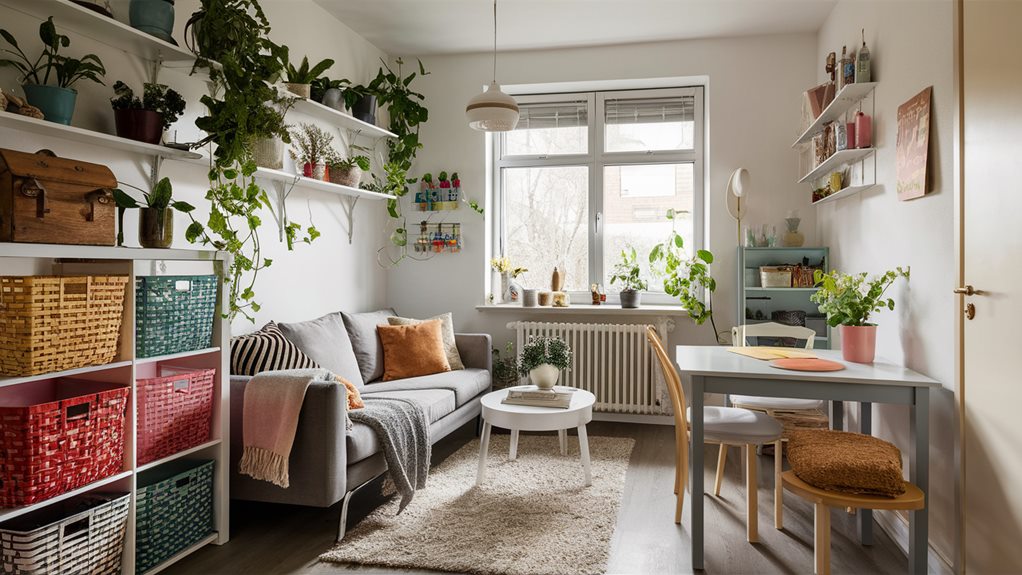You can transform your small living space into an organized oasis with a few essential tips. Start by measuring your room, then declutter regularly to make room for what truly matters. Choose multi-functional furniture to save space, and maximize vertical storage with shelves and hooks. Use baskets and containers to keep things tidy and create defined zones in your space. Don't forget under-bed storage and optimize your closet with shelves and clear bins. Finally, maintain clear surfaces by adopting a minimalist approach. Want to explore additional strategies to enhance your small space? Keep going for more insights!
Key Takeaways
- Embrace multi-functional furniture like sofa beds and storage ottomans to maximize utility in small spaces.
- Implement vertical storage solutions such as wall shelves and hanging organizers to keep items off the floor.
- Use baskets and containers for organized storage, labeling them for easy identification and maintenance.
- Optimize under-bed storage with bins or vacuum-sealed bags to utilize every inch of your living space.
- Maintain clear surfaces by adopting a minimalist decor approach and establishing a daily tidy-up routine.
Assess Your Space

To make the most of your small living space, you need to start with a clear assessment of what you have. Begin by measuring each room to understand its dimensions. This'll help you visualize the space utilization potential. Create a simple sketch of your room layout, noting where doors, windows, and electrical outlets are located. This foundational step allows you to identify how furniture and storage can fit within your space. Consider incorporating space-saving solutions, similar to how foldable picnic tables maximize outdoor areas while maintaining functionality.
Next, consider how you use each room. Think about your daily activities and how they impact your space. For instance, if your living area serves as both a relaxation zone and a workspace, you'll want to guarantee it accommodates both functions without feeling cramped. Identify any underutilized areas, like corners or nooks, where you can add shelves or compact furniture.
Pay attention to the scale of furniture you choose. Opt for pieces that are proportional to your room layout. A large sofa can overwhelm a small space, while a sleek loveseat can create a more open feel. Additionally, multifunctional furniture—like ottomans with storage—can enhance space utilization by serving more than one purpose.
Declutter Regularly
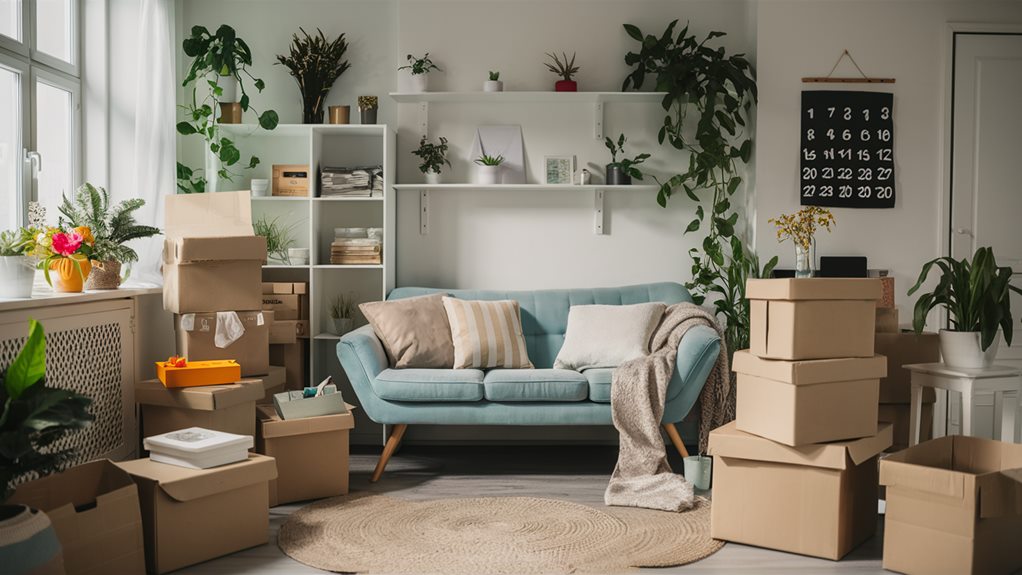
A clutter-free space makes a world of difference in small living areas. Embracing minimalist living isn't just a trend; it's a lifestyle that can enhance your well-being and create a more peaceful environment. Regularly decluttering is pivotal to maintaining that space. Start by setting aside time each week or month to evaluate your belongings.
Consider implementing drawer organizers for cutlery to keep your kitchen neat, which can help streamline your cooking process and reduce clutter.
As you go through your items, consider the benefits of decluttering. Ask yourself: Do you really use this? Is it adding value to your life? If it's just taking up space, it might be time to let go. Remember, emotional attachment to possessions can be strong, but it's crucial to differentiate between items that hold sentimental value and those that simply clutter your home.
When you find it hard to part with something, think about the joy it brings you—or the lack thereof. If it's not serving a purpose, consider donating, selling, or recycling it. This not only frees up valuable space but also contributes to a more sustainable lifestyle.
Make decluttering a habit. Create a checklist for different areas of your home, tackling one space at a time. You'll find that with each item you let go of, you're not just clearing out physical clutter, but also making room for new experiences and memories.
Use Multi-Functional Furniture
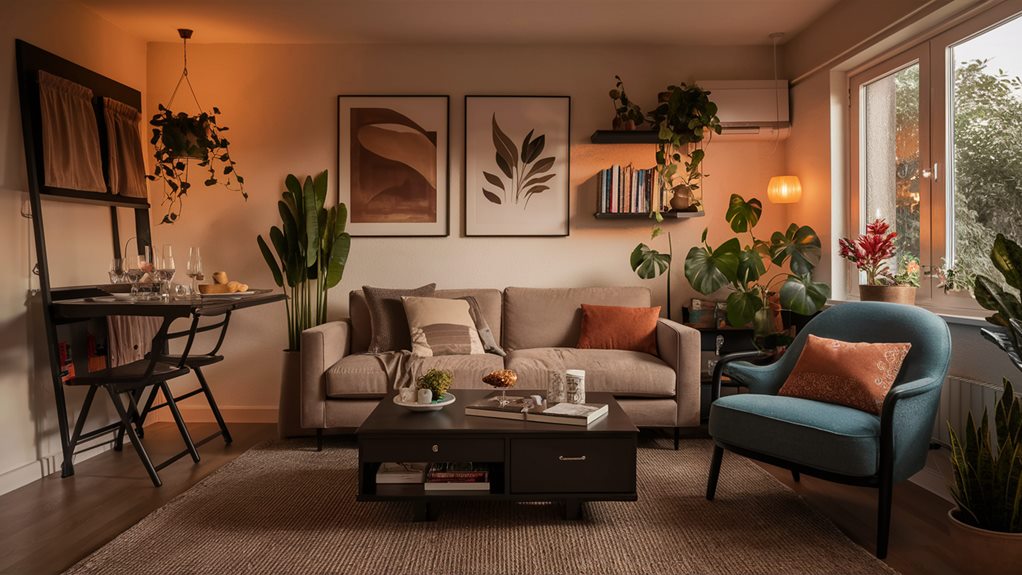
After decluttering, the next step in maximizing your small living space is to invest in multi-functional furniture. This type of furniture not only saves space but also enhances the functional design of your home. Think about pieces that can serve more than one purpose, such as a sofa bed, an ottoman with storage, or a coffee table that doubles as a desk. For additional convenience, consider incorporating foldable laundry baskets that can easily be stored away when not in use. These space-saving solutions allow you to use your area more efficiently without sacrificing comfort or style.
When choosing multi-functional furniture, consider your lifestyle and needs. If you love hosting friends, a dining table that extends can be perfect. For those who work from home, a compact desk that transforms into a console table can make a big difference. Look for items with clean lines and a modern aesthetic to keep your space feeling open and inviting.
Additionally, consider furniture that can be easily moved or reconfigured, like modular seating arrangements. These give you the flexibility to adapt your space for different occasions, creating a warm and welcoming environment.
Maximize Vertical Storage
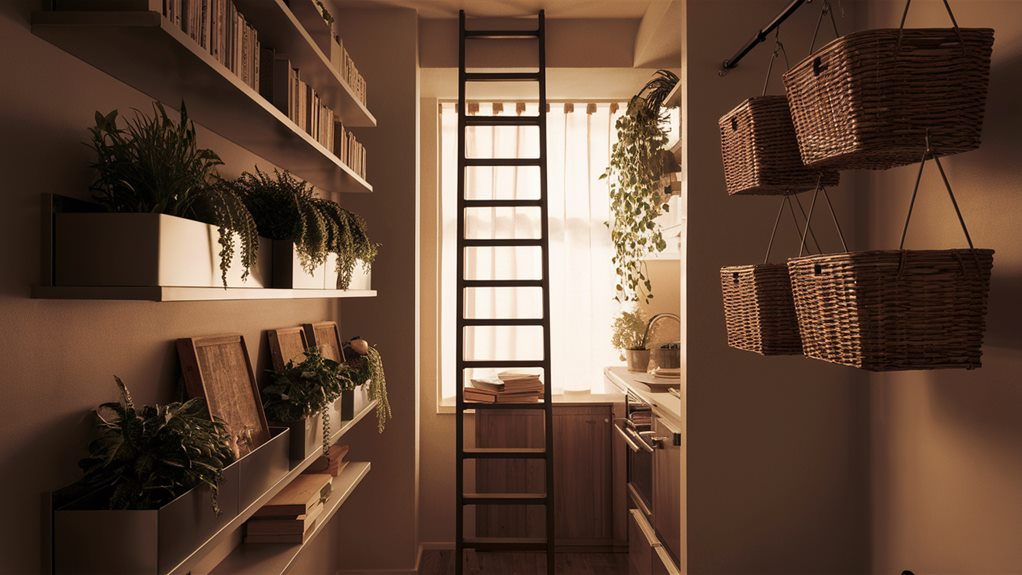
Utilizing vertical space is key to organizing small living areas effectively. You can transform your cramped space into a more functional environment by thinking upwards. Start by installing wall shelves. These not only keep your items off the floor but also create an attractive display for books, plants, or decorative accents. When choosing shelves, opt for open designs that maintain a sense of airiness while maximizing storage.
In addition to wall shelves, consider using hanging organizers. These are perfect for storing items like shoes, accessories, or cleaning supplies without taking up precious floor space. You can hang them on doors or walls to keep everything within easy reach yet neatly organized.
Door hooks are another great solution. They allow you to utilize the back of doors for hanging bags, coats, or towels, freeing up closet and floor space. Install a few hooks in strategic locations, like the bathroom or entryway, to create a clutter-free environment.
Don't overlook hanging racks either. These can be used in kitchens for pots and pans or in laundry rooms for drying clothes. By using vertical storage solutions, you can keep your belongings organized and easily accessible, which helps create a sense of belonging in your home.
With these tips, you'll maximize your vertical storage potential and make your small living space feel more open and inviting. Embrace the vertical!
Organize With Baskets and Containers

Organizing your small living space becomes much easier with the right baskets and containers at your disposal. These tools not only help you declutter but also create a sense of belonging by giving your items a designated home.
Start by selecting baskets and containers that fit your aesthetic and space. Consider using various sizes to accommodate different items, from larger bins for blankets to smaller baskets for miscellaneous items.
Next, implement a labeling system. This allows everyone in the household to know where things belong, making it simple to maintain organization. Use clear labels or tags—whether handwritten or printed—to identify the contents of each container. This way, you can quickly find what you need without rummaging through clutter.
Color coding is another effective strategy. Assign specific colors to different categories of items. For example, you might use blue baskets for office supplies, green for toys, and red for seasonal decorations. This visual cue not only enhances the aesthetic appeal but also simplifies the process of putting things away.
Place your baskets and containers strategically throughout your space. Utilize shelves, under beds, and corners to maximize their effectiveness. By organizing with baskets and containers, you create a harmonious environment where everything has its place, making your small living space feel more inviting and functional. Embrace these techniques, and you'll find that maintaining order becomes a seamless part of your daily routine.
Create Defined Zones
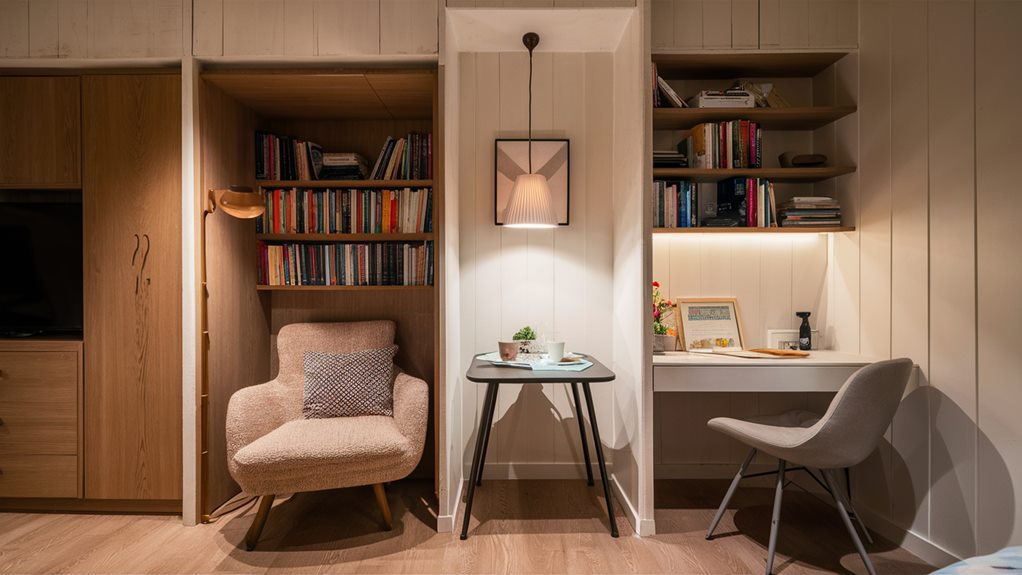
Creating defined zones in your small living space helps you maximize functionality and maintain order. By establishing a clear zone layout, you can transform a cramped area into a well-organized haven where each part serves a distinct purpose. Start by evaluating your space and identifying how you use it daily. This insight will guide your space planning decisions.
Begin by dividing your living area into specific zones, such as a reading nook, work area, or dining space. Use furniture placement to create boundaries; for instance, a sofa can separate your living area from a workspace. Consider multifunctional furniture, like a desk that doubles as a dining table, to save space while still defining zones.
Next, think about visual cues. Rugs are excellent for delineating zones—placing a rug under your coffee table can distinguish the living area from the rest.
Similarly, shelving units can act as both storage and room dividers, enhancing your zone layout while providing extra organization.
Don't forget about vertical space. Wall-mounted shelves or hooks can help keep items off the floor, making your zones feel more open and inviting.
Utilize Under-Bed Storage

One of the best ways to maximize your small living space is to take advantage of under-bed storage. This often-overlooked area can be a game-changer for your bedroom organization. By utilizing under-bed storage solutions, you can keep your belongings out of sight while still having them easily accessible.
Here are a few effective under-bed storage ideas:
| Type of Storage | Best For | Recommended Items |
|---|---|---|
| Storage Bins | Seasonal clothing | Winter coats, summer wear |
| Rolling Drawers | Everyday essentials | Shoes, accessories |
| Vacuum-Sealed Bags | Bulky items | Comforters, extra linens |
| Bed Risers | Increased space | Any items you want to store |
Consider investing in storage bins or rolling drawers that fit comfortably under your bed. These options not only help with organization but also add a layer of practicality to your space. Vacuum-sealed bags can help you save even more space by compressing bulky items, while bed risers create additional clearance for even more storage solutions.
Optimize Closet Space
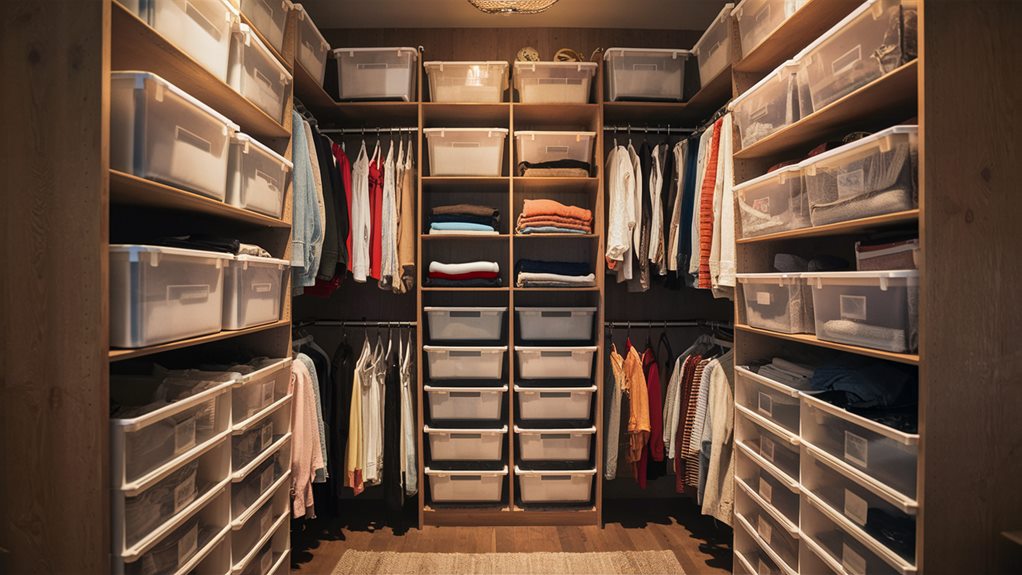
Maximizing closet space is essential for maintaining order in a small living area. To make the most of your closet, start by decluttering. Take everything out and assess what you truly need. Donate or discard items that you haven't used in a while. Once you've streamlined your belongings, it's time to implement efficient storage solutions.
Consider adding a shoe rack to the base of your closet. This not only keeps your shoes organized but also frees up valuable floor space. Choose a vertical shoe rack if you're short on room; it'll hold more pairs without taking up extra width.
Next, install hanging shelves above the shoe rack or along any free wall space. These shelves can hold boxes, bags, or seasonal clothing, allowing you to maximize vertical storage. Use clear bins for visibility or labeled boxes for easy identification, so you can quickly grab what you need.
Utilizing cascading hangers can also save space by allowing multiple garments to hang vertically. This is especially useful for items like blouses and dresses.
Lastly, don't forget about the door! A hanging organizer can be a perfect spot for accessories or smaller items. By creatively using every inch of your closet, you'll not only keep your space tidy, but you'll also cultivate a more functional and inviting environment. Remember, a well-organized closet contributes to a sense of belonging and peace in your small living space.
Keep Surfaces Clear
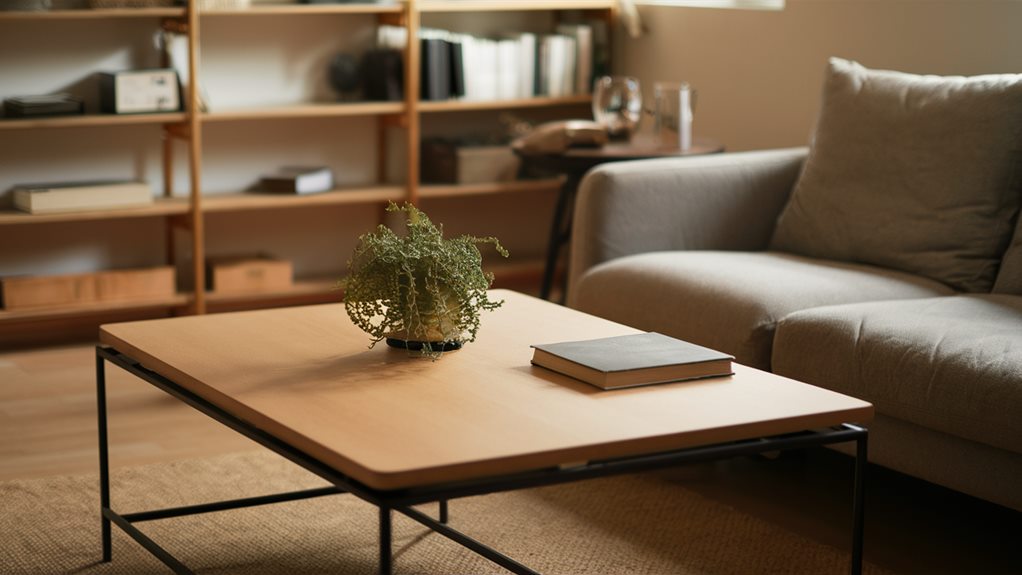
Your living space's surfaces can easily become cluttered, making it feel smaller and less inviting. To create a more open and welcoming environment, focus on keeping surfaces clear. Start by evaluating your countertops, tables, and shelves. If they're piled with items, it's time for a change.
Adopt a minimalist decor approach. This means prioritizing essential items and letting go of the rest. Choose a few decorative pieces that reflect your personality, and avoid overcrowding surfaces with knick-knacks. Remember, less is more when it comes to creating a sense of space.
Next, utilize hidden storage to keep everyday items out of sight. Look for furniture that doubles as storage, like ottomans or coffee tables with compartments. Invest in decorative boxes or baskets that can fit neatly on shelves or under tables. These solutions not only reduce clutter but also contribute to your overall decor.
Make it a habit to do a quick daily tidy-up. At the end of the day, take five minutes to clear surfaces. Put away any items that don't belong and wipe down surfaces to maintain a fresh look.
Lastly, designate specific spots for frequently used items. By creating a system, you'll find it easier to keep everything in its place. With clear surfaces, your small living space will feel larger, more organized, and ultimately, a more inviting place to belong.
Frequently Asked Questions
How Can I Choose the Right Color Scheme for a Small Space?
To choose the right color scheme for your small space, consider color psychology. Lighter hues like pastels can make the area feel larger and more inviting. Pair these with space-saving furniture that complements your chosen palette.
Use accent colors to add personality without overwhelming the space. Stick to a limited color palette to maintain cohesion, and don't forget to incorporate textures to create warmth and depth, making your space feel like home.
What Are the Best Plants for Small Living Environments?
To bring life into your small space, consider vertical gardening and succulent arrangements. Vertical gardens maximize wall space, allowing you to incorporate various plants without occupying valuable floor area. Choose easy-care succulents for arrangements; they thrive in compact spaces and require minimal maintenance.
Mix textures and colors to create visual interest. By selecting the right plants, you'll transform your environment into a cozy haven that fosters a sense of belonging and warmth.
How Does Lighting Affect the Feel of a Small Room?
You might say lighting is the heart and soul of a room, especially in a cozy space. Natural light creates warmth and openness, making you feel at home.
In contrast, artificial lighting can add a touch of charm or intimacy, depending on how you place it. Strategically positioning lamps and fixtures can highlight your favorite corners, transforming the ambiance.
What Are Some Budget-Friendly Organizing Solutions for Tiny Homes?
When you're looking for budget-friendly organizing solutions for tiny homes, consider using space-saving furniture like foldable tables or ottomans with hidden storage.
You can also create DIY storage solutions, like wall-mounted shelves or repurposed crates, to maximize vertical space.
These options not only keep your belongings organized but also enhance the room's functionality.
Get creative with your available materials, and you'll find that a little ingenuity goes a long way in optimizing your living space.
How Can I Maintain Organization During Seasonal Changes?
To maintain organization during seasonal shifts, start by evaluating your space. Use storage solutions like bins or baskets to separate seasonal items. For closet organization, rotate clothes by season, placing off-season items in labeled containers. Invest in slim hangers to maximize space and keep everything visible. Regularly declutter to make sure you're only keeping what you need. This systematic approach keeps your belongings organized and makes changes smoother, allowing you to enjoy each season effortlessly.
Conclusion
So, you thought living in a small space meant sacrificing comfort, didn't you? With these organizing tips, you can actually turn your cozy quarters into a stylish haven. By evaluating your space, decluttering regularly, and using multi-functional furniture, you'll create a home that feels much larger than it is. Remember, it's not about having more stuff, but making the most of what you have. Who knew small living could feel so spacious and inviting?

